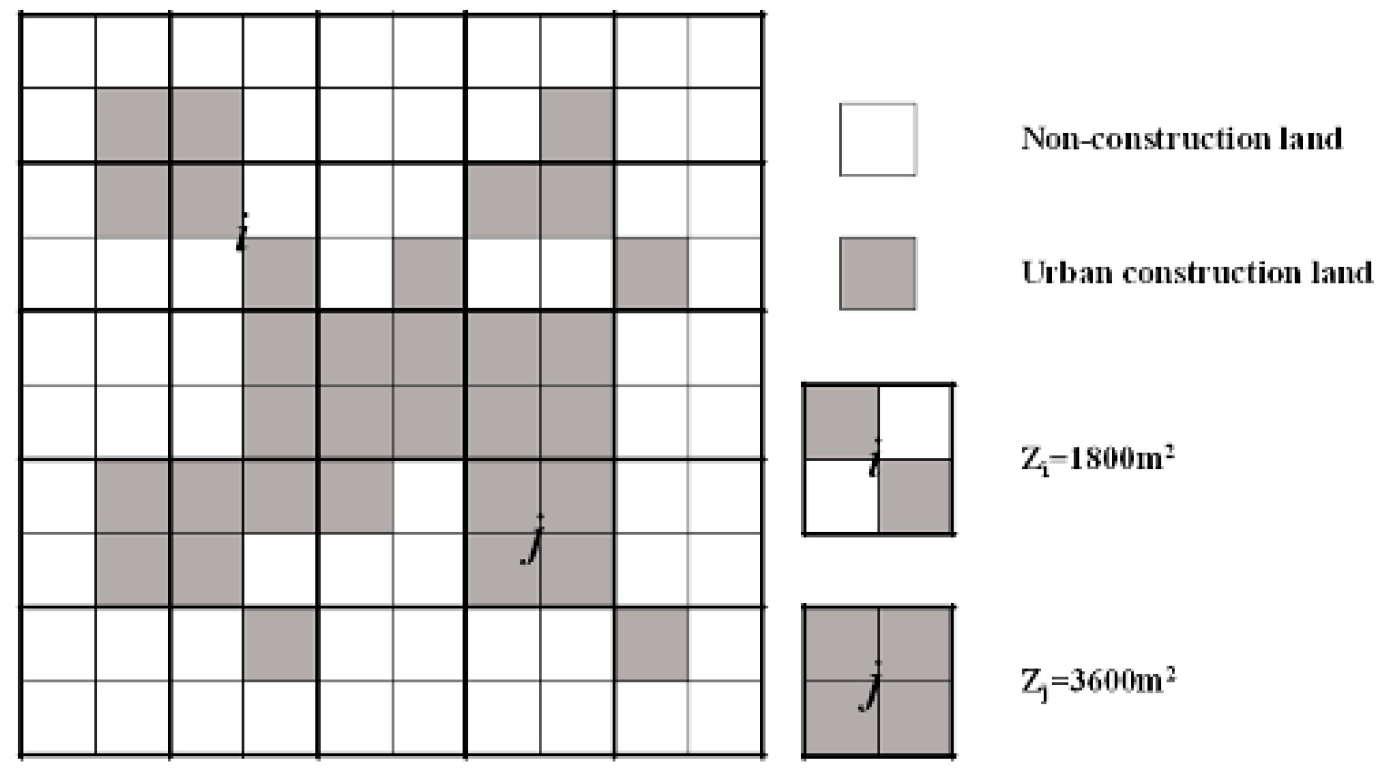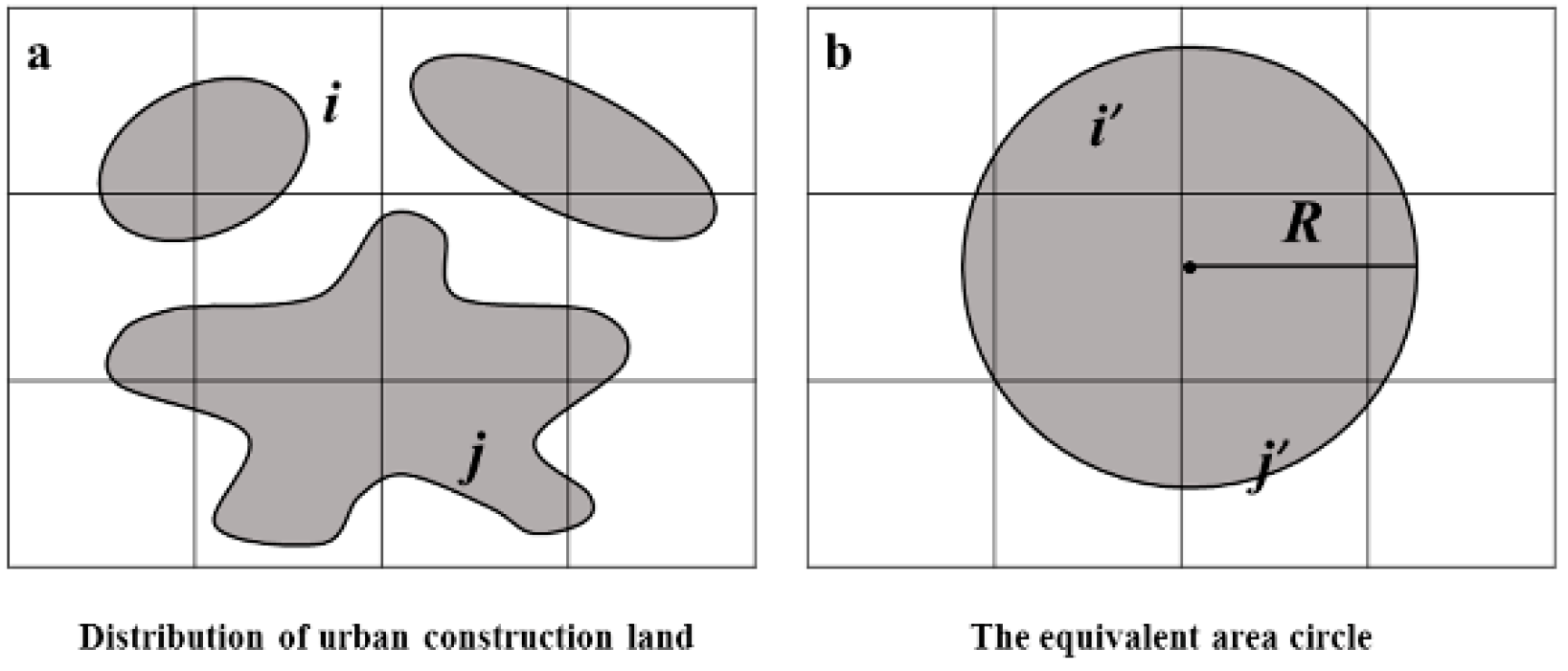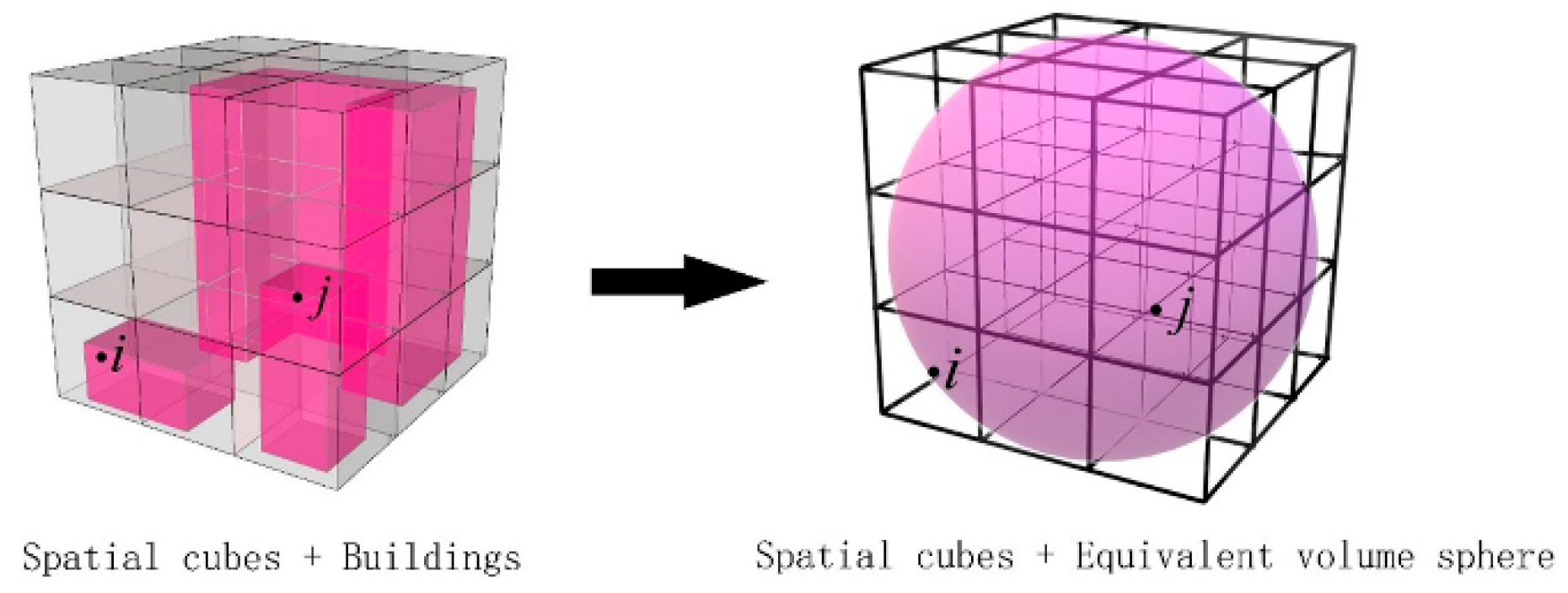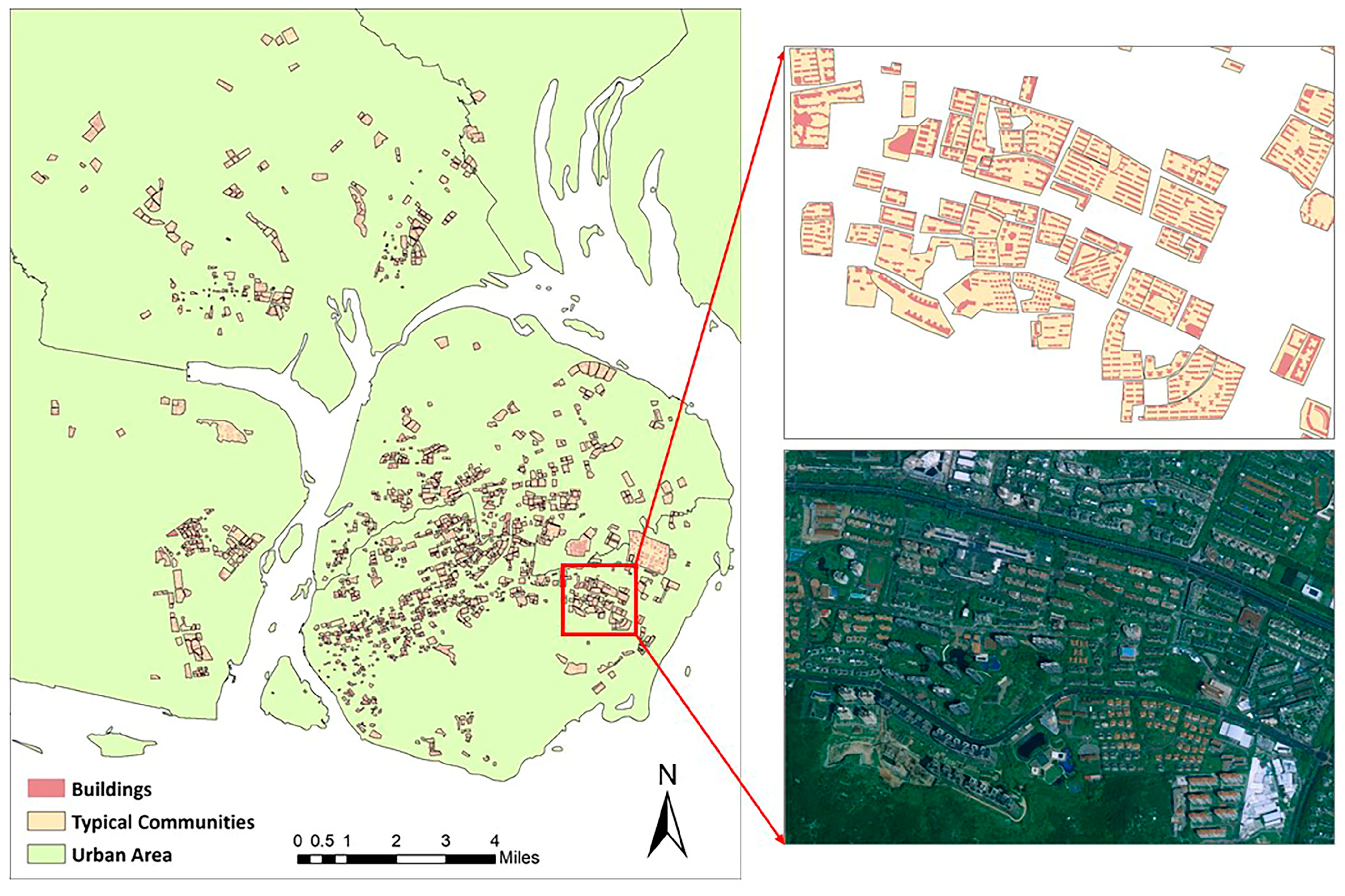A Promotional Construction Approach for an Urban Three-Dimensional Compactness Model—Law-of-Gravitation-Based
Abstract
1. Introduction
2. Method
2.1. Law of Gravitation
2.2. 2D Urban Compactness Index Model Based on Law of Gravitation
2.3. Normalization of 2D Urban Compactness Index Model
2.4. 3D Compactness Index (VCI)
2.5. Normalized 3D Compactness Index (NVCI)
3. Model Verification
3.1. Case Study
3.2. Results and Discussions
4. Conclusions
Author Contributions
Funding
Acknowledgments
Conflicts of Interest
References
- Dantzig, G.B. The ORSA New Orleans Address on Compact City. Manag. Sci. 1973, 19, 1151–1161. [Google Scholar] [CrossRef]
- Brotchie, J.F. Compact city, a plan for a liveable urban environment: G.A. Danzig and T.L. Saaty. Urban Ecol. 1975, 1, 325–328. [Google Scholar] [CrossRef]
- Borrego, C.; Martins, H.; Tchepel, O.; Salmim, L.; Monteiro, A.; Miranda, A.I. How urban structure can affect city sustainability from an air quality perspective. Environ. Model. Softw. 2006, 21, 461–467. [Google Scholar] [CrossRef]
- Breuste, J.; Astner, A. Which kind of nature is liked in urban context? A case study of solarcity linz, Austria. Mitt. Der Osterreichischen Geogr. Ges. 2017, 159, 105–129. [Google Scholar]
- Paul, V.; Tonts, M. Containing Urban Sprawl: Trends in Land Use and Spatial Planning in the Metropolitan Region of Barcelona. J. Environ. Plan. Manag. 2005, 48, 7–35. [Google Scholar] [CrossRef]
- Ye, H.; Hu, X.; Ren, Q.; Lin, T.; Li, X.; Zhang, G.; Shi, L. Effect of urban micro-climatic regulation ability on public building energy usage carbon emission. Energy Build. 2017, 154, 553–559. [Google Scholar] [CrossRef]
- Artmann, M.; Inostroza, L.; Fan, P. Urban sprawl, compact urban development and green cities. How much do we know, how much do we agree? Ecol. Indic. 2019, 96, 3–9. [Google Scholar] [CrossRef]
- Ye, H.; He, X.; Song, Y.; Li, X.; Zhang, G.; Lin, T.; Xiao, L. A sustainable urban form: The challenges of compactness from the viewpoint of energy consumption and carbon emission. Energy Build. 2015, 93, 90–98. [Google Scholar] [CrossRef]
- Ye, H.; Qiu, Q.; Zhang, G.; Lin, T.; Li, X. Effects of natural environment on urban household energy usage carbon emissions. Energy Build. 2013, 65, 113–118. [Google Scholar] [CrossRef]
- Ye, H.; Ren, Q.; Hu, X.; Lin, T.; Shi, L.; Zhang, G.; Li, X. Modeling energy-related CO2 emissions from office buildings using general regression neural network. Resour. Conserv. Recycl. 2018, 129, 168–174. [Google Scholar] [CrossRef]
- Ye, H.; Ren, Q.; Shi, L.; Song, J.; Hu, X.; Li, X.; Zhang, G.; Lin, T.; Xue, X. The role of climate, construction quality, microclimate, and socio-economic conditions on carbon emissions from office buildings in China. J. Clean. Prod. 2018, 171, 911–916. [Google Scholar] [CrossRef]
- Van der Waals, J.F.M. The compact city and the environment: A review. Tijdschr. Voor Econ. En Soc. Geogr. 2000, 91, 111–121. [Google Scholar] [CrossRef]
- Burton, E. Measuring urban compactness in UK towns and cities. Environ. Plan. B-Plan. Des. 2002, 29, 219–250. [Google Scholar] [CrossRef]
- Habitat III. New Urban Agenda; United Nations: Quito, Ecuador, 2017.
- United Nations Framework Convention on Climate Change (UNFCCC). Paris Agreement; United Nations: New York, NY, USA, 2016.
- United Nations Sustainable Development Group (UNSDG). About the Sustainable Development Goals; United Nations: New York, NY, USA, 2015.
- United Nations International Strategy for Disaster Reduction (UNISDR). Sendai Framework for Disaster Risk Reduction 2015–2030; United Nations: Sendai, Japan, 2015.
- The Intergovernmental Panel on Climate Change (IPCC). Climate Change 2007: Impacts, Adaptation and Vulnerability; Cambridge University Press: Cambridge, UK, 2007.
- Sharifi, A. Trade-offs and conflicts between urban climate change mitigation and adaptation measures: A literature review. J. Clean. Prod. 2020, 276, 122813. [Google Scholar] [CrossRef]
- Cervero, R. Efficient Urbanisation: Economic Performance and the Shape of the Metropolis. Urban. Stud. 2001, 38, 1651–1671. [Google Scholar] [CrossRef]
- Reilly, M.K.; O’Mara, M.P.; Seto, K.C. From Bangalore to the Bay Area: Comparing transportation and activity accessibility as drivers of urban growth. Landsc. Urban. Plan. 2009, 92, 24–33. [Google Scholar] [CrossRef]
- Song, Y. Study on the Theories and Assessment Methodologies of the Compact City; University of Chinese Academy of Sciences: Beijing, China, 2011. [Google Scholar]
- Gaigne, C.; Riou, S.; Thisse, J.-F. Are compact cities environmentally friendly? J. Urban. Econ. 2012, 72, 123–136. [Google Scholar] [CrossRef]
- Burton, E. The Compact City: Just or Just Compact? A Preliminary Analysis. Urban Stud. 2000, 37, 1969–2006. [Google Scholar] [CrossRef]
- Lau, S.S.Y.; Yang, F.; Tai, J.; Wu, X.L.; Wang, J. The study of summer-time heat island, built form and fabric in a densely built urban environment in compact Chinese cities: Hong Kong, Guangzhou. Int. J. Sustain. Dev. 2011, 14, 30–48. [Google Scholar] [CrossRef]
- Pierer, C.; Creutzig, F. Star-shaped cities alleviate trade-off between climate change mitigation and adaptation. Environ. Res. Lett. 2019, 14, 085011. [Google Scholar] [CrossRef]
- Stokes, E.C.; Seto, K.C. Climate change and urban land systems: Bridging the gaps between urbanism and land science. J. Land Use Sci. 2016, 11, 698–708. [Google Scholar] [CrossRef]
- Richardson, H.W. Harry Ward Richardson; Saxon House: Lexington, KY, USA, 1973. [Google Scholar]
- Gibbs, J.P. Urban. Research Methods. NEW YORK; Van Nostrand: Princeton, NJ, USA, 1961. [Google Scholar]
- Cole, J.P. Study of Major and Minor. Civil. Division in Pllitical Geography; Miemgraphed: Seattle, WA, USA, 1960. [Google Scholar]
- Bertaud, A.; Malpezzi, S. The Spatial Distribution of Population in 35 World Cities: The Role of Markets, Planning, and Topography; University of Wisconsin Center for Urban Land Economic Research: Wisconsin, WI, USA, 2001. [Google Scholar]
- Galster, G.; Hanson, R.; Ratcliffe, M.R.; Wolman, H.; Coleman, S.; Freihage, J. Wrestling sprawl to the ground: Defining and measuring an elusive concept. Hous. Policy Debate 2001, 12, 681–717. [Google Scholar] [CrossRef]
- Chuanglin, F.; Weifeng, Q.I. Research Progress and Thinking of Compact City and Its Measurement Methods. Urban Plan. Forum 2007, 4, 65–73. [Google Scholar]
- Chuanglin, F.; Weifeng, Q.I.; Jitao, S. Researches on Comprehensive Measurement of Compactness of Urban Agglomerations in China. Acta Geogr. Sin. 2008, 63, 1011–1021. [Google Scholar]
- Thinh, N.X.; Arlt, G.; Heber, B.; Hennersdorf, J.; Lehmann, I. Evaluation of urban land-use structures with a view to sustainable development. Environ. Impact Assess. Rev. 2002, 22, 475–492. [Google Scholar] [CrossRef]
- Zhao, F.; Tang, L.; Qiu, Q.; Wu, G. The compactness of spatial structure in Chinese cities: Measurement, clustering patterns and influencing factors. Ecosyst. Health Sustain. 2020, 6, 1743763. [Google Scholar] [CrossRef]
- Padmanabhan, T. Gravitation: Foundations and Frontiera; Peking University Press: Beijing, China, 2013. [Google Scholar]
- Newton, I. Mathematical Principles of Natural Philosophy; University of California Press: Oakland, CA, USA, 1999. [Google Scholar]
- Zhao, J.; Song, Y.; Shi, L.; Tang, L. Study on the compactness assessment model of urban spatial form. Acta Ecol. Sin. 2011, 31, 6338–6343. [Google Scholar]
- Sun, M. Digital Image Processing and Analysis: MATLAB and VC++ Implementation; Electron. Industry Press: Beijing, China, 2013. [Google Scholar]





| Community ID | Location (District) | NCI | NVCI | Average Height (m) | Density | Plot Ratio |
|---|---|---|---|---|---|---|
| Lianfabinhaimingju (LFBH) | Siming | 0.554 | 0.005 | 50.000 | 0.124 | 3.031 |
| Jinfengyuan (JFY) | Siming | 0.554 | 0.007 | 21.353 | 0.368 | 2.932 |
| Xiagangxincun (XGXC) | Siming | 0.554 | 0.014 | 15.167 | 0.350 | 2.226 |
| Dunshangxiaoqu (DSXQ) | Huli | 0.554 | 0.022 | 28.909 | 0.235 | 3.149 |
| Jinqiuhuayuan (JQHY) | Huli | 0.554 | 0.022 | 23.571 | 0.379 | 3.850 |
| Shuichanjituan (SCJT) | Siming | 0.554 | 0.032 | 12.250 | 0.319 | 2.091 |
| Wanjinghuayuan (WJHY) | Huli | 0.554 | 0.045 | 19.500 | 0.387 | 2.654 |
| Lvquanxincun (LQXC) | Siming | 0.554 | 0.054 | 13.286 | 0.448 | 2.812 |
| Dongrongshequ (DRSQ) | Huli | 0.554 | 0.061 | 16.600 | 0.408 | 2.875 |
© 2020 by the authors. Licensee MDPI, Basel, Switzerland. This article is an open access article distributed under the terms and conditions of the Creative Commons Attribution (CC BY) license (http://creativecommons.org/licenses/by/4.0/).
Share and Cite
Hu, X.; Yan, H.; Wang, D.; Zhao, Z.; Zhang, G.; Lin, T.; Ye, H. A Promotional Construction Approach for an Urban Three-Dimensional Compactness Model—Law-of-Gravitation-Based. Sustainability 2020, 12, 6777. https://doi.org/10.3390/su12176777
Hu X, Yan H, Wang D, Zhao Z, Zhang G, Lin T, Ye H. A Promotional Construction Approach for an Urban Three-Dimensional Compactness Model—Law-of-Gravitation-Based. Sustainability. 2020; 12(17):6777. https://doi.org/10.3390/su12176777
Chicago/Turabian StyleHu, Xinyue, Han Yan, Deng Wang, Zhuoqun Zhao, Guoqin Zhang, Tao Lin, and Hong Ye. 2020. "A Promotional Construction Approach for an Urban Three-Dimensional Compactness Model—Law-of-Gravitation-Based" Sustainability 12, no. 17: 6777. https://doi.org/10.3390/su12176777
APA StyleHu, X., Yan, H., Wang, D., Zhao, Z., Zhang, G., Lin, T., & Ye, H. (2020). A Promotional Construction Approach for an Urban Three-Dimensional Compactness Model—Law-of-Gravitation-Based. Sustainability, 12(17), 6777. https://doi.org/10.3390/su12176777





